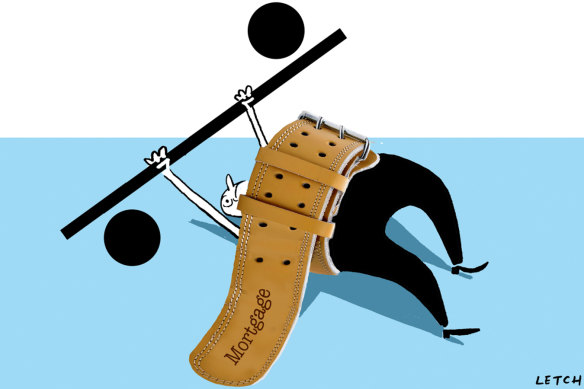Opinion
Cost-of-living crisis? Why only some of us are feeling the pinch
Ross Gittins
Economics EditorIf you believe the opinion polls, we’re all groaning under the weight of the cost-of-living crisis. And Treasurer Jim Chalmers confirms we’ve all been “under the pump”. But it’s not that simple. Some of us are doing it a lot tougher than others. And some of us are actually ahead on the deal.
In any case, where did the living-cost crisis come from? That bit’s simple. The economy’s been on a rollercoaster for the past 4½ years. COVID and the lockdowns may seem a distant memory, but almost everything that has happened in the economy since the end of 2019 has been the direct or indirect consequence of the pandemic.

Illustration by Simon Letch
The surge in consumer prices that began in early 2022 stemmed from a combination of temporary disruptions to supply caused by the pandemic, and excess demand for goods and services as people spent the money they’d earned but couldn’t spend during the lockdowns.
The tax cuts that began this month had been planned for six years, but Chalmers changed their intended shape radically to help people most affected by the cost of living. They mean that, by the end of this year, overall living standards should be just a little up on where they were five years ago.
Just as the media focus on bad news more than good news, so you and I focus more on what’s been happening to the cost of living than what’s been happening to our after-tax income. But it’s the difference between the two – our standard of living – that matters most.
Two economists at the Australian National University’s Centre for Social Policy Research, Associate Professor Ben Phillips and Professor Matthew Gray, have been crunching the numbers, and their results may surprise you.
They’ve examined the change in our standard of living since the end of 2019, and included a forecast up to the end of this year, to take account of the latest tax cuts and changes in the May budget.
Lumping all households together, they find that we did quite well in 2020 and 2021 as the Reserve Bank cut interest rates and governments spent billions on such things as the JobKeeper scheme and temporary doubling of JobSeeker unemployment benefits. But then living standards fell sharply in 2022 as consumer prices took off and housing costs rose. Living standards fell a little further last year, taking them to 0.6 per cent lower than they were before COVID arrived.
The authors estimate that, this year, the tax cuts and continuing pay rises will lift living standards to a princely 1.6 per cent above what they were in December 2019.
But those national averages conceal much variation. When the authors ranked all households by their disposable income, then divided them into five quintiles, the poorest 20 per cent are expected to end the five years with their living standard 3.5 per cent higher.
Huh? They did well partly because their pensions and benefits are indexed to inflation.
At the same time, the top 20 per cent of households are expected to be 2.7 per cent ahead. Why? Partly because they did well on their investments.
So it’s the middle 60 per cent of households that have been hit the hardest by the cost of living. The second lowest 20 per cent barely broke even, while the middle and upper-middle quintiles suffered a fall in their living standards.
But now we get to the pointy bit. Why did the middle do so much worse than the rest? Because that’s where you find most of the people with mortgages. Turns out all those households with mortgages are expected to see their living standards fall by 5.6 per cent over the five years to December 2024.
What about renters? Their living standards should rise by 2.9 per cent over the period. Huh? How could that be? It’s true that shortages of rental accommodation have caused rents to rise hugely this year and last. But much of that can be seen as catch-up for the lockdown-caused falls in rents in 2020 and 2021, and the small increases in 2022.
If you’re sitting down, I’ll tell you that the living standards of people who own their homes outright are expected to rise by … 8.5 per cent.
But here’s an even bigger shock: if you divide all the households by their main source of income, those in the “other” category – that is, not reliant on either wages or pensions – should see their standard of living rise by what the authors call “an astounding 15.8 per cent”.
Penny dropped yet? Yes, we’re talking about the group that always has its hand out for a handout to thank it for being too well-off to get the age pension: the self-described, so-called self-funded retirees. But while you’re feeling sorry for all those poor souls (whose company I’ll be joining one day), spare a kick for the economists who, several decades ago, had the bright idea of using only interest rates to control inflation. They must have had a fairness bypass.
Ross Gittins is the economics editor.
Ross Gittins unpacks the economy in an exclusive subscriber-only newsletter. Sign up to receive it every Tuesday evening.